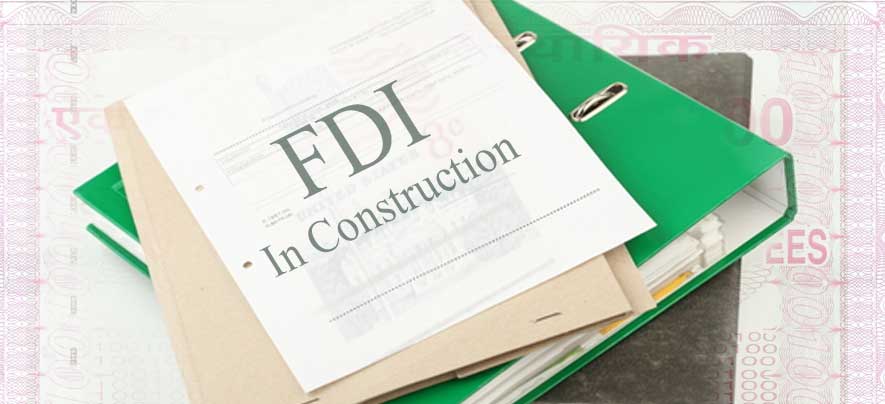Foreign Direct Investment in the Construction Development Sector-Amendments Approved by the Union Cabinet

Economy
554 week ago — 7 min read
Since taking charge in May 2014, the Government of India has initiated various liberalisation measures to attract foreign investments. Apart from Foreign Direct Investment (“FDI”) relaxations covering projects in rail infrastructure, defense and construction development (being townships, housing and built-up infrastructure, etc.), the recent changes also streamline the process of obtaining industrial licenses.
While FDI in real estate/construction development has been permitted since 2005, it has been subject to many conditions like development of minimum area, minimum capitalisation, investment lock-in, restriction on FDI in residential plots, restriction on transfer of shares, etc. These conditions could be met only by the big industry players.
The recent announcement by the Union Cabinet relaxing the FDI norms in the construction development send out a positive signal. While the formal press note is still awaited, we have attempted to compare the existing policy related to construction development with the proposed policy.
Minimum area to be developed
Existing Policy
- A minimum land area of 10 hectares in case of development of serviced housing plots.
- A minimum built-up area of 50,000 square meters in case of construction development projects.
- Any one of the above two conditions need to be complied with in case of a combination project.
Proposed Policy
- No minimum land area requirement.
- The term “serviced housing plots” has been revised to “serviced plots”, thereby allowing companies to also develop serviced commercial plots as well.
- The minimum area reduced to 20,000 square meters.
- No minimum area condition prescribed in case of combination projects
Minimum capitalisation requirements
Existing Policy
- The minimum capitalisation of USD 10 million required in case of wholly owned subsidiaries and USD 5 million in case of joint ventures.
- This condition is required to be complied within a period of 6 (six) months from the date of commencement of the project (“Project Commencement Date”)*.
Proposed Policy
- The minimum capitalisation requirement in case of wholly owned subsidiaries has also been reduced to USD 5 million.
- The prescribed period for compliance remains the same.
Special benefits in case of affordable housing
Proposed Policy
- The requirements of ‘minimum area to be developed’ and ‘minimum capitalisation requirements’ will not be applicable in case of projects which commit at least 30% of the total project cost for low-cost affordable housing.**
Lock-in Period
Existing Policy
- Original investment shall be locked-in and cannot be repatriated before a period of 3 (three) years from date of completion of minimum capitalisation.
- The lock-in period will be applied from the date of receipt of each installment of FDI or from the date of completion of minimum capitalisation, whichever is later. Any early exit to the investor will require prior approval of the Government through Foreign Investment and Promotion Board (“FIPB”)
Proposed Policy
- Exit has been permitted to the investor immediately after the completion of the project or after 3 (three) years from the date of final investment, subject to the development of trunk infrastructure.***
Transfer of shares
Existing Policy
- Transfer from one non-resident investor to another non-resident investor and repatriation (if any) involved therein, before completion of the project is not permitted.
Proposed Policy
- Transfer from one non-resident investor to another non-resident investor and repatriation (if any) involved therein, has been permitted before completion of the project, subject to prior approval of the Government through FIPB
Waiver of period of development
Existing Policy
- At least 50% of each such project must be developed within a period of 5 (five) years from the Project Commencement Date.
Proposed Policy
- At least 50% of each such project must be developed within a period of 5 (five) years from the Project Commencement Date has been removed.
Operation and management of townships, malls etc. (Completed projects)
Proposed Policy
- 100% FDI under the automatic route is permitted for operation and management of townships, malls/shopping complexes and business centers.
Investor responsibilities
Existing Policy
- The investors will be required to provide necessary infrastructure (roads, water supply, street lighting, drainage, sewerage, etc.).
- The investors will have the obligation to obtain completion certificate.
Proposed Policy
- Above mentioned responsibilities of Investors have been removed
Advaya Legal’s View: It is a welcome step to give the required boost to construction and development sector, promote affordable housing and resultant employment generation. The foreign inflows in the sector have been showing a declining trend since 2009-2010 .The changes, especially with regard to ‘minimum area to be developed’ and ‘reduction in minimum capitalisation’ are expected to encourage foreign investors to set up wholly owned subsidiaries. Having said that, trunk infrastructure still remains a problem in major cities in the country, without which the development of the sector will always be a challenging task. The amendments are in line with new Government’s vision to establish 100 new cities to reduce the burden on metro cities.
Article Courtsey: http://advayalegal.com/newsletter/Newsletter%20-%20November%202014.pdf
--------------------------------------
*The date of approval of building plan/layout plan by statutory authority will be treated as the date of commencement of the project.
**Projects using at least 60% of the FAR/FSI for dwelling units of Carpet Area not more than 60 square meters will be considered as Affordable Housing Projects. In addition, 35% of the total number of dwelling units constructed should be of carpet area 21-27 sqm for EWS category. Such projects can have a mix of EWS/LIG/Higher Category DUs and commercial units. Provision of servant's quarter along with the main dwelling unit will not be counted as dwelling units for EWS/LIG under Affordable Housing project.
*** Trunk infrastructure shall include roads, water supply, street lighting, drainage and sewerage.
Posted by
GlobalLinker StaffWe are a team of experienced industry professionals committed to sharing our knowledge and skills with small & medium enterprises.
View GlobalLinker 's profile
Most read this week













Comments
Share this content
Please login or Register to join the discussion